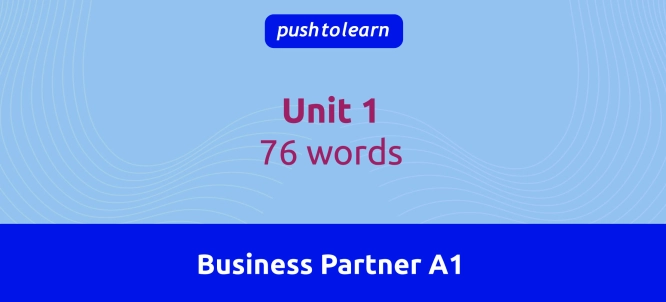by PushtoLearn
Unit 1
Table of Contents
Unit 1, Business Partner A1 - Exercises
These exercises focus on vocabulary from Unit 1 of Business Partner A1
Countries and Nationalities
Learning to talk about countries and nationalities is useful for introductions, travel, and discussions about culture. Here’s a list of common countries and nationalities, along with how to use them in sentences.
Table: Countries and Nationalities
|
Country |
Nationality |
Example Sentence |
|
Argentina |
Argentinian |
"She is Argentinian and loves dancing tango." |
|
Brazil |
Brazilian |
"He is Brazilian and speaks Portuguese." |
|
China |
Chinese |
"The Chinese New Year is an important holiday." |
|
Germany |
German |
"German cars are known for their quality." |
|
India |
Indian |
"He enjoys traditional Indian food." |
|
Ireland |
Irish |
"The Irish love celebrating St. Patrick's Day." |
|
Japan |
Japanese |
"Japanese gardens are very peaceful." |
|
Mexico |
Mexican |
"Mexican food is famous worldwide." |
|
Poland |
Polish |
"She loves Polish folk music." |
|
Spain |
Spanish |
"Spanish culture is vibrant and colorful." |
|
The UK |
British |
"Many famous writers are British." |
|
The USA |
American |
"The American flag has 50 stars." |
Tips for Usage
-
Country vs. Nationality: Use the country name (e.g., "India") when talking about the place and the nationality (e.g., "Indian") when describing a person or their characteristics.
-
Correct: "He is from China. He is Chinese."
-
Incorrect: "He is from Chinese."
-
Capitalization: Always capitalize country names and nationalities.
-
Correct: "German, Irish"
-
Incorrect: "german, irish"
Common Errors
-
Confusing country and nationality: Remember, “Japan” is the country, but a person from Japan is “Japanese.”

Personal Details
Knowing how to give and ask for personal details is important for forms, meetings, and introductions. Here’s a list of terms commonly used in personal information.
Table: Personal Details
|
Term |
Definition |
Example |
|
Address |
Location where someone lives |
"My address is 12 Maple Street." |
|
Email Address |
Online contact information |
"My email is info@example.com." |
|
Emergency Contact |
Contact in case of emergency |
"My emergency contact is my sister." |
|
First Name |
A person’s given name |
"My first name is John." |
|
Gender |
Identity as male or female |
"My gender is female." |
|
Home Address |
Residential address |
"Home address: 45 Oak Ave." |
|
ID Card Number |
Identification number on an ID |
"ID card number: 12345678." |
|
Mobile Number |
Personal cell phone number |
"My mobile number is 555-1234." |
|
Post Code |
Postal code for an address |
"Post code: 54321." |
|
Surname |
A person’s last name |
"My surname is Smith." |
|
Title |
Prefix used before a name |
"Title: Mr., Ms., Dr." |
|
Dot |
Symbol (.) often in emails |
"Example: john.doe@example.com" |
|
Hyphen |
Symbol (-) often in phone numbers or names |
"Example: mother-in-law" |
|
Lower Case |
Small letters, not capitalized |
"Email is in lower case." |
|
Male |
Gender identity |
"Male or female?" |
|
Female |
Gender identity |
"Male or female?" |
|
Marital Status |
Relationship status, e.g., single, married |
"Marital status: married." |
Tips for Usage
-
Formatting Names: Start with your title (Mr., Ms., Dr.), then your first name, and finally your surname.
Example: "Mr. John Smith"
-
Emails: Use “dot” and “hyphen” to read out email addresses.
Example: "john.doe@example.com" would be read as "john dot doe at example dot com."
Common Errors
-
Lowercase and Uppercase: Be careful with letters in email addresses. Usually, they are in lowercase.
-
Hyphens in Names: Hyphens are used in double-barrelled names, like "Smith-Jones."
Describing Your Company
These terms help you describe the workplace, facilities, and items commonly found in a company.
Table: Company Descriptions and Facilities
|
Term |
Definition |
Example |
|
Building |
Structure or place of work |
"Our building has three floors." |
|
Canteen |
Place where employees eat |
"The canteen serves lunch daily." |
|
Employee Break Room |
Room where employees take breaks |
"We relax in the employee break room." |
|
Facilities |
Equipment or areas provided for comfort |
"Our facilities include a gym." |
|
Factory |
Place where goods are produced |
"The factory is very large." |
|
Office |
Room where office work happens |
"I work in an open office." |
|
Warehouse |
Large storage place for goods |
"Goods are stored in the warehouse." |
|
Division |
Separate area or group within a company |
"I work in the sales division." |
|
Production |
The process of making goods |
"Production happens on the first floor." |
|
Sales |
Department that sells products |
"Sales are up this quarter." |
|
Coffee |
Common hot drink in offices |
"Would you like a coffee?" |
|
Milk, Sugar, Tea |
Common additions for coffee/tea |
"We have milk and sugar." |
|
Coffee Machine |
Machine that makes coffee |
"The coffee machine is in the break room." |
|
Laptop |
Portable computer |
"I use a laptop for work." |
|
Photocopier |
Machine to make copies |
"The photocopier is out of paper." |
|
Printer |
Machine that prints documents |
"Please use the printer for reports." |
Tips for Usage
-
Describing Company Size and Type: Use adjectives like "large," "small," "modern," or "old-fashioned."
Example: "Our office is modern and has many facilities."
-
Adding Details about Spaces: Use phrases like "includes," "is located," or "has a" to give more detail.
Example: "The factory includes a break room and a canteen."
Common Errors
Mixing Up Company Areas: Make sure to distinguish between terms like “factory” (where goods are made) and “warehouse” (where goods are stored).
FAQ
What is the difference between country and nationality?
A country is a place (e.g., “Japan”), while nationality describes people from that place (e.g., “Japanese”).
How should I format an email address?
Email addresses are in lowercase and may include dots or hyphens, like “john.doe@example.com”.
What does “ID card number” mean?
It’s a unique number on your identification card, used to verify identity.
How do I describe a modern office?
Use words like “modern,” “light,” and “large,” e.g., “Our modern office has large windows.”
What is the difference between “factory” and “warehouse”?
A factory is where products are made, while a warehouse is where products are stored before shipping.
